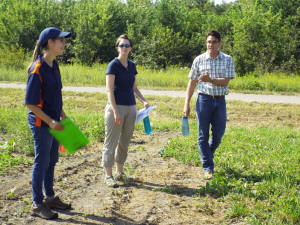|
Among the speakers were a team from the University of Illinois.
The U of I has a test plot on the farm in rural Atlanta and are
studying the impact of various cover crops on soil retention,
nutrient retention, and other benefits to the environment.
University of Illinois: Dr. Tony Yannarell, Elizabeth Miernicki,
and Cassandra Wilcoxen

University of Illinois, Associate Professor of Microbial
Ecology, Natural Resources and Environmental Sciences, Dr. Tony
Yannarell; and graduate students Elizabeth Miernicki and
Cassandra Wilcoxen, each gave brief talks on the work that is
being done at the test plot.
This is the third year of the test plot at the farm and has been
led by three different people. Therefore, Dr. Yannarell said he
had inherited the program well under way and was continuing the
work of those who came before him.
The test plot is divided into 50-square-foot sections and
included a section with no cover crop at all that is used as the
control. Six crops are being grown, one species per small plot,
and also combined in varieties of two and three species per
plot. Elizabeth Miernicki said that her work was with wildlife
and pollinators. She said her studies were to examine what cover
crops are best attractors for birds and pollinator insects,
particularly birds. She said that speaking generally, there are
more species of birds, and higher populations of birds in soils
with cover crops as opposed to those soils without.
In the pollinator studies, she is examining the populations of
butterflies. She said at this point, the populations are not
present, which is representative of other work and reports
indicating that through pesticides, a large number of butterfly
species, particularly the monarchs are becoming extinct in our
country.
Cassandra Wilcoxen is studying urban food production. She said
her work was to determine the long-term effects of urban soil
systems. She’s been working with raised beds, and mixing soil
types for high production. Her study has included a test of six
soil treatments that include compost only, compost-top soil
combinations, and direct soil alone, as well as mixed with
compost and topsoil. She said the bed with the higher content of
compost is performing at the highest level, and the bed that is
direct soil only is performing poorly.
Dr. Yannarell said what his program is looking at is the impact
of the cover crop on soil quality. The goal is to work with
cover crops that will draw in the nutrients from the soil, and
can be returned to the soil with tillage.
Other goals studying the use of cover crops include erosion
control of the top soils, as well as prevention of nutrient
leaching into waterways. Another study that is ongoing is weed
suppression using cover crops. Dr. Yannarell explained that the
cover crops could suffocate out the weed population, which can
be beneficial to the organic farmer in particular.
Richard Ritter, Gridley Branch of Flanagan State Bank

With the plot tour over, guests returned to tent area to hear
from Richard Ritter of Flanagan State Bank. Ritter’s Bank is one
of a few banks that are aggressively working with organic
producers.
Ritter said that three years ago he was asked to speak at a Land
Connection meeting. Though he had a farming background, he felt
he needed to research more about sustainable farming. He was
disturbed to find that there are not many resources out there
that will give good detailed information. He then decided it was
his “calling” to take up this subject and provide better
information. Ritter said 2016 had been an interesting year,
with half of the producers hoping for drought, and half looking
for record yields. The reason being, many farms are taking
financial hit. A crop loss and higher prices or a record crop in
spite of lower prices, could pull them out of the fire.
[to top of second column] |


Looking at conventional farm yields last year, he said some might
have thought that it was a good year because yields were higher than
they have had for the past five, ten, and even 20 years. But...,
prices were down, and input costs were up. Consequently, Ritter said
2015 was at very best an average year and in the opinion of many, a
less than average year.
Ritter offered a handout that offered some income comparisons
between conventional crops versus organic crops. In his first
comparison, he produced numbers for production costs versus income,
and showed the group where that high soybean yields of 60 to 80
bushels of conventional soybeans showed a clear or net income of
only about half of the net income from an organic field with yields
at 36 to 80 bushels per acre. The reason for the difference is based
on the increased selling price, not decreased costs.
Ritter said that it is a common misconception that organic farming
means no costs involved in weed control or fertilizer. He said that
was not true, especially with fertilizer, where that an organic
farmer will pay a premium price for organic fertilizers.
Ritter said another good thing to point out, is that for so long, it
appeared that organic crop yields were much lower than the yields of
conventional crops. He said this is no longer the case. Yields off
of organic fields are coming in within 75 percent of the comparable
conventional crop.
Ritter said that the future of organic farming is strong. He said
there are a number of reasons for this, but perhaps the best reason
is the consumer. He said that consumers are looking for organic and
are willing to pay the premium for it.
He noted that eggs, for example, are selling for about $4.00 in the
organic market, compared to less than a dollar or $1.50 in the
conventional market, yet there continues to be a high demand for
organic eggs.
This trend is continuing throughout the food market, with people
looking for healthy and safe choices where they have no worries
about the use of chemicals or genetically modified (GMO) products.
He added that there are statistics that show that 73 percent of all
Americans are consuming some organically grown products.
Ritter said the other good news for organic farming is that
landowners are looking for producers who will go organic on their
land. So, the demand for the organic producer is growing among the
landlord community. He said the reason for this was not just organic
farming practices, but also profitability. He said landlords see
that there are greater returns in organic production than in
conventional farming.
Ritter said another benefit to transitioning away from conventional
farming, was the income potential that will allow multiple
generations to live off the family farm. It is a problem that the
lack of stable income in conventional farming is causing young
people to leave the farm for their careers. But, with the potential
in food farming to yield as much as $15,000 per acre, even a small
farm can support a family.
So what is the downside to organic farming? Ritter asked the
questioned and answered it saying, it is hard work. He noted some
young folks just aren’t going to work as hard as they need to make
organic farming profitable.
Ritter said that in general, to survive, the farming community is
going to have to keep an open mind, and be adaptable to the changes
that need to be made. He predicted that at the end of this season,
there would be 10 percent fewer farmers. He said land cost is also
going to be dropping. To stay afloat, farmers need to look at
alternatives such as organic farming, which is more work, but also a
greater net return.
The next speaker on the list was Barbara Barcal of All Star Trading,
who spoke about the income potential for organic and non-GMO crops,
as well as the competition from overseas.
The last four speakers of the day included Barcal, John Bianucci of
Iroquois Valley Farms, and Bill Davison, University of Illinois'
Grand Prairie Grain Guild; and Joe Bybee of the University of
Illinois – The Illinois Nutrient Loss Reduction Strategy.
LDN will offer coverage from all of these speakers in the final
segment of this series.
[Nila Smith] |